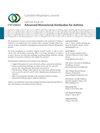Comparison of Auto- and Fixed-Continuous Positive Airway Pressure on Air Leak in Patients with Obstructive Sleep Apnea: Data from a Randomized Controlled Trial
IF 2.1
4区 医学
Q3 RESPIRATORY SYSTEM
引用次数: 6
Abstract
Auto-CPAP may cause sleep fragmentation due to variations in pressure and unintentional leaks. The aim of this study was to compare air leak between fixed-CPAP and auto-CPAP after 4 months of CPAP treatment. This study is an ancillary analysis of a randomized, double-blind, parallel, controlled trial over 4 months, comparing fixed- and auto-CPAP in newly diagnosed patients with OSA. The following data were extracted from the CPAP devices: mean and 90th percentile pressure, residual apnea-hypopnea index, mean CPAP use, and amount of leak. Within each arm, patients were also randomly allocated to use of one of the three different brands of devices. Since the leak was reported differently for each device, median leak value was determined for each brand and leaks were classified as “above the median” or “below the median”. Data from 269 patients were analyzed. The univariate analysis showed that tobacco consumption, CPAP level, and oronasal masks were associated with leaks above the median value but not the type of CPAP. The multivariate analysis showed that only CPAP level and oronasal masks were associated with leaks below the median. There were no differences in the types of mask used between fixed- and auto-CPAP. There was no impact of the type of CPAP on leaks or the type of interface used. We used a method based on the median leak value to standardize comparisons across devices which report leaks with different definitions.自动和固定持续气道正压对阻塞性睡眠呼吸暂停患者漏气的影响:一项随机对照试验的数据
由于压力变化和无意泄漏,自动cpap可能导致睡眠中断。本研究的目的是比较固定CPAP和自动CPAP治疗4个月后的空气泄漏情况。本研究是一项为期4个月的随机、双盲、平行、对照试验的辅助分析,比较了固定cpap和自动cpap在新诊断的OSA患者中的应用。从CPAP设备中提取以下数据:平均和第90百分位压力、剩余呼吸暂停低通气指数、平均CPAP使用率和泄漏量。在每组中,患者也被随机分配使用三种不同品牌的设备之一。由于每个设备的泄漏报告不同,因此确定了每个品牌的中位数泄漏值,并将泄漏分类为“高于中位数”或“低于中位数”。分析了269例患者的数据。单变量分析显示,烟草消费、CPAP水平和口鼻口罩与中位数以上的泄漏相关,但与CPAP类型无关。多变量分析显示,只有CPAP水平和口鼻面罩与中位数以下泄漏相关。在固定cpap和自动cpap之间使用的面罩类型没有差异。CPAP的类型和使用的接口类型对泄漏没有影响。我们使用了一种基于中位数泄漏值的方法来标准化跨设备的比较,这些设备报告具有不同定义的泄漏。
本文章由计算机程序翻译,如有差异,请以英文原文为准。
求助全文
约1分钟内获得全文
求助全文
来源期刊

Canadian respiratory journal
医学-呼吸系统
CiteScore
4.20
自引率
0.00%
发文量
61
审稿时长
6-12 weeks
期刊介绍:
Canadian Respiratory Journal is a peer-reviewed, Open Access journal that aims to provide a multidisciplinary forum for research in all areas of respiratory medicine. The journal publishes original research articles, review articles, and clinical studies related to asthma, allergy, COPD, non-invasive ventilation, therapeutic intervention, lung cancer, airway and lung infections, as well as any other respiratory diseases.
 求助内容:
求助内容: 应助结果提醒方式:
应助结果提醒方式:


